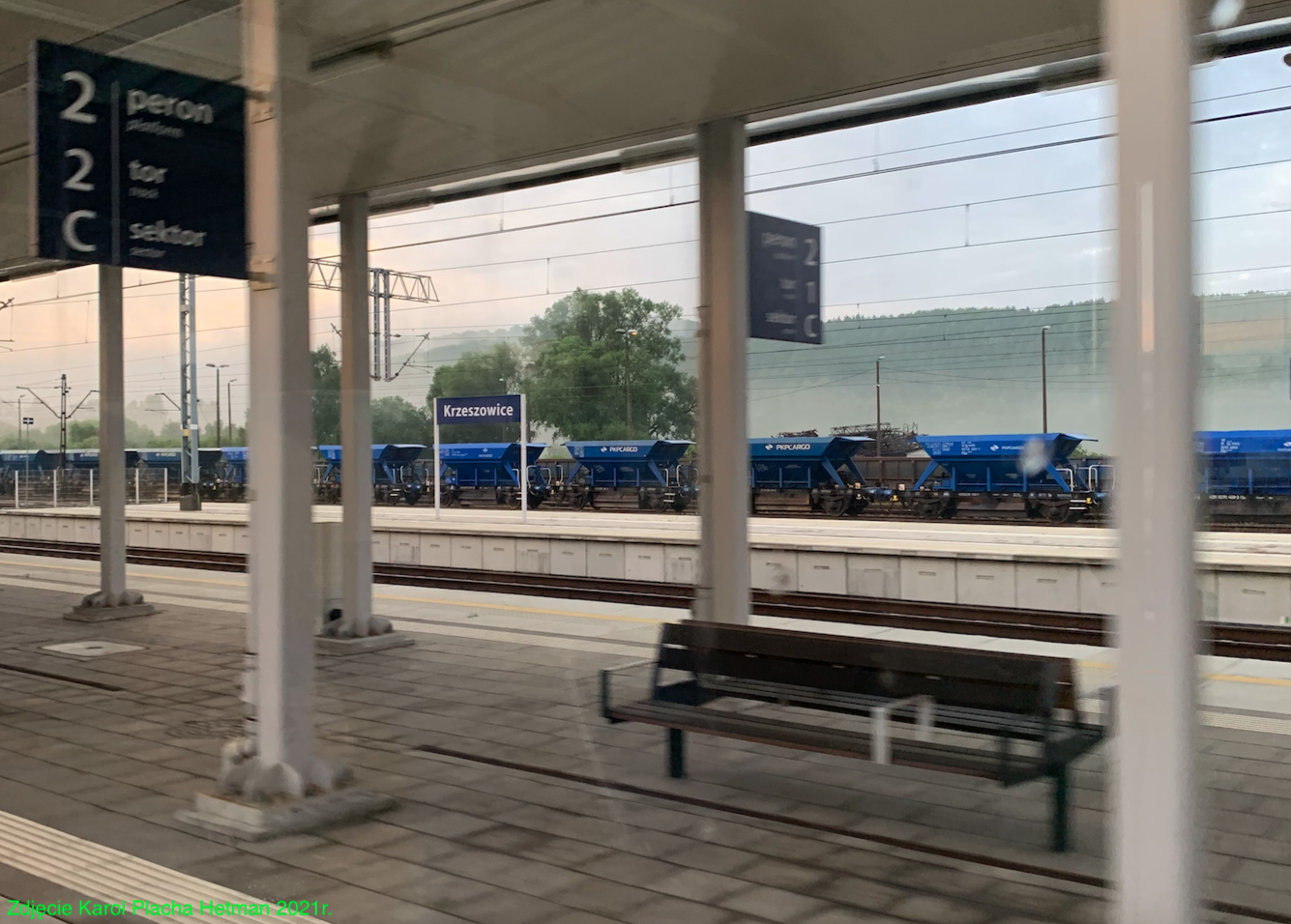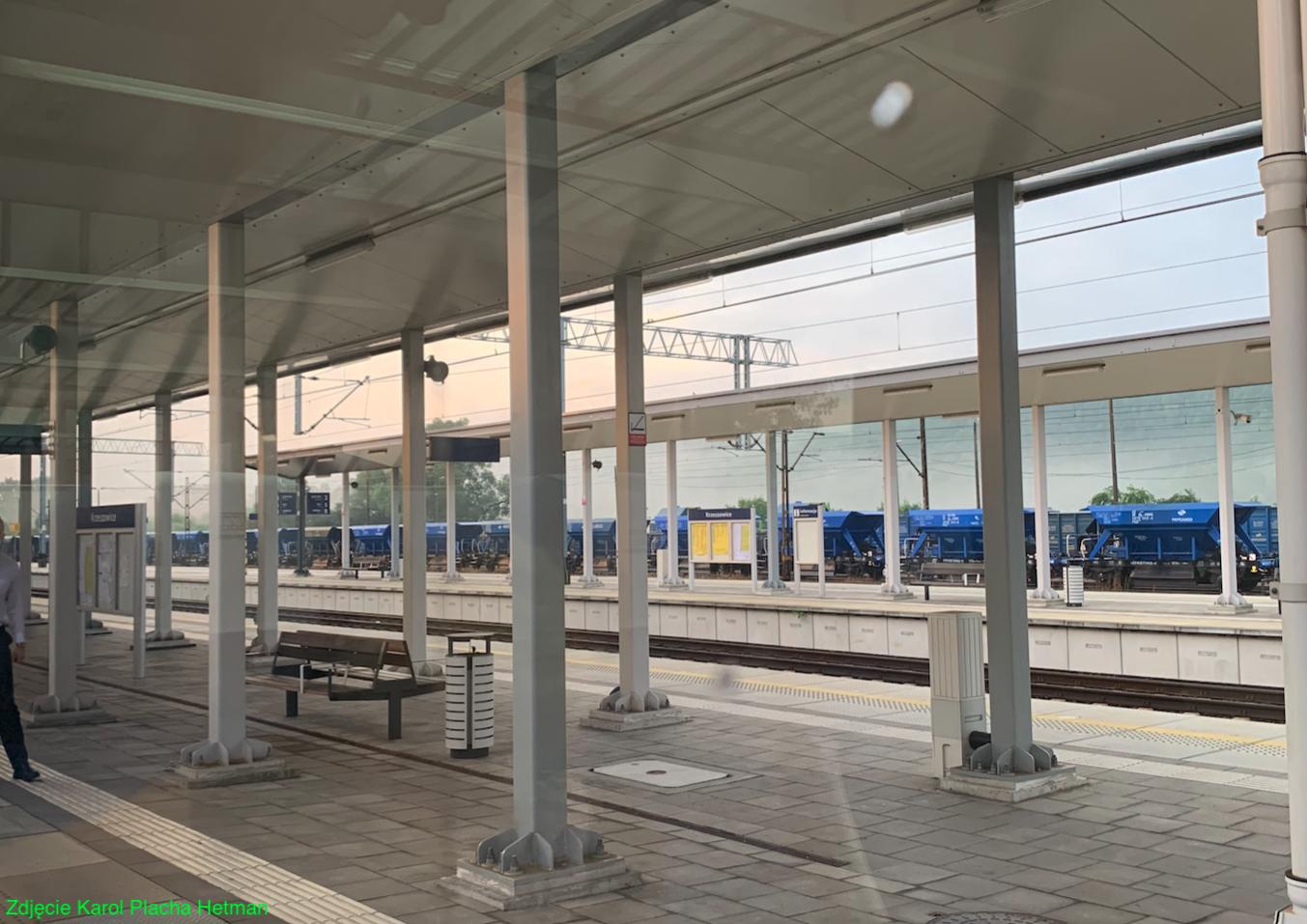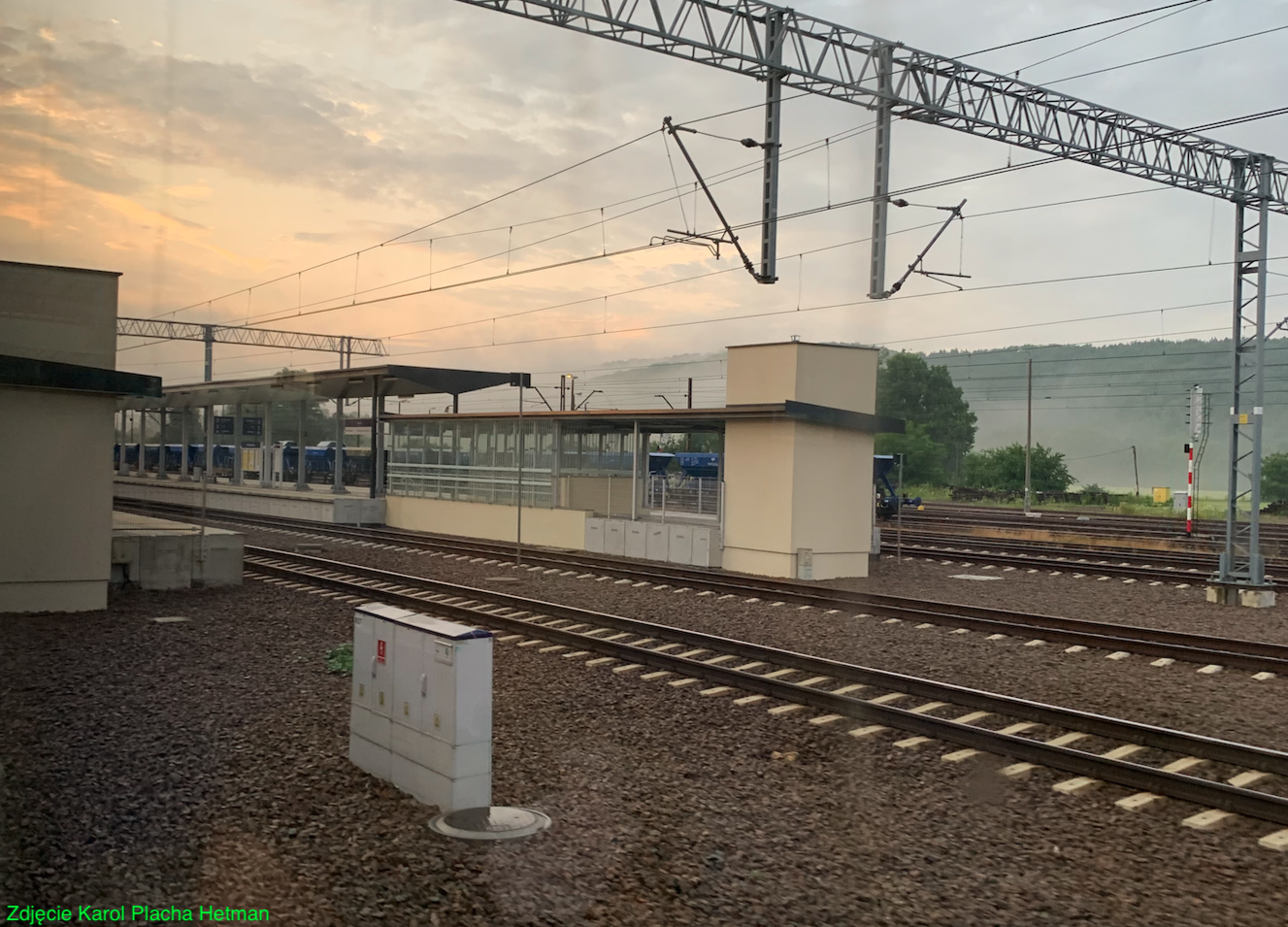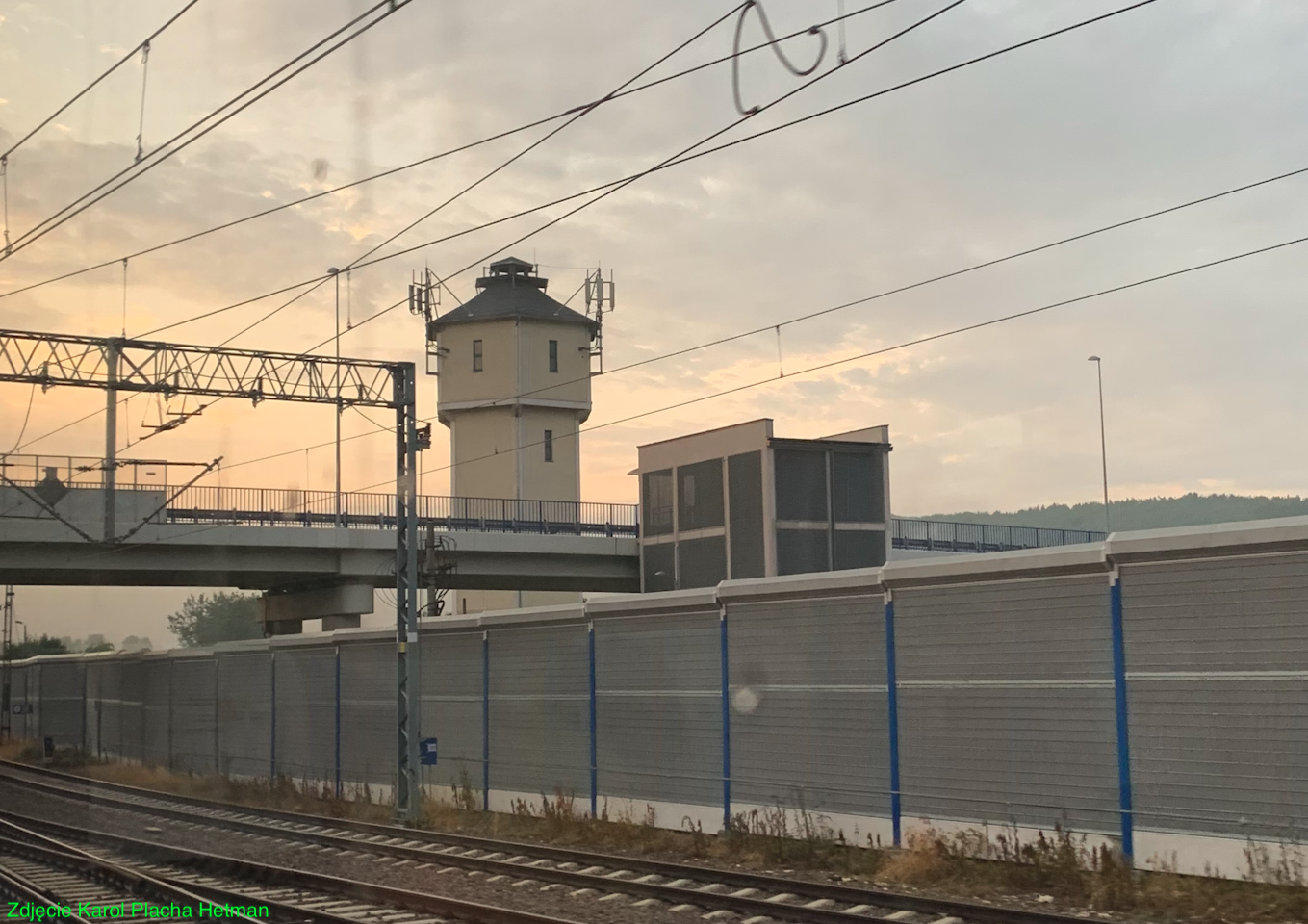Krzeszowice 2023-02-06
Railway station in Krzeszowice near Krakow.
Geographic coordinates: 50.131N 19.634E.




Krzeszowice is a town in the south of Poland, in the Lesser Poland Voivodeship, in the Krakow poviat. The area of the city is 16.92 km2. The population is 9,975 inhabitants (2019). City Hall, address: ul. Grunwaldzka 4, 32-065 Krzeszowice.
Distance from Krzeszowice to: Kraków - 27 km. Trzebinia - 13 km. Olkusz - 19 km. Myslowice - 40 km. Katowice - 53 km. Warsaw - 290 km. The national road No. 79 Warsaw - Kraków - Krzeszowice - Katowice - Bytom runs through the town. Krzeszowice borders on the Tenczyński Landscape Park from the south. The Krzeszowice Commune is located in the southern part of the Krakow-Częstochowa Upland. The plateau was formed during the Alpine movements, revealing numerous igneous rocks: porphyries, dolomites, diabases. Therefore, there are numerous quarries in the area. There is no shortage of various karst forms, such as caves, and numerous mineral waters.
The settlement was founded in 1286. City rights were granted in 1933. Krzeszowice belongs to the Jaworzno-Chrzanów Industrial District. The village was founded as a noble one. The first Roman Catholic parish was founded in 1337. In 1555, Krzeszowice became the property of Count Stanisław Tęczyński and became part of the Tęczyński County. After the extinction of the male line of the Tęczyńskis, Krzeszowice was owned successively by the Sieniawskis, the Opalińskis, the Czartoryskis, the Lubomirskis, and from 1816, the Potockis. It was the Potocki family that developed Krzeszowice industrially and culturally. In the second half of the 18th century, the local springs were discovered to have healing properties. In the period 1928 - 1967, Krzeszowice had the status of a health resort where locomotive organs were treated. Currently, Krzeszowice is again applying for the status of a health resort.
In the period 1815–1846, Krzeszowice belonged to the Free City of Kraków (Republic of Kraków). In connection with the partitions, the local population was involved in both the Krakow Uprising (1846) and the January Uprising (1863), for which the surrounding towns were important points of transfer of weapons and insurgents to the Kingdom.
In the period 1840 - 1844, a neo-gothic church was built in Krzeszowice. In the period 1850 - 1857, the Potockis built a palace in the style of the Italian Renaissance. Its cubic capacity is 43,000 m3, it consists of 228 different chambers. With the beginning of the construction of the palace, a landscape park with the features of an English park was established.
At the end of the 19th century, industry developed in Krzeszowice, the main driving force of which was the railway. New production plants were established: a steam sawmill (1894), a barrel factory, a roof tiles and drainage factory, an earth paint factory (1906), a cement and concrete products factory (1907). New quarries opened.
In 1919, the Commune Council applied to the authorities of the Republic of Poland for municipal rights. There was an immediate consent, but the formalities and the creation of the state act meant that the document was issued on October 18, 1933.
After the lost defensive war of 1939, the Germans incorporated Krzeszowice into the general governorship. Governor Hans Frank's head turned so much that all the palaces in the general government became his summer residences, starting with the Wawel Royal Castle, through the Potocki Palace in Krzeszowice, through the castle in Przegorzały, and ending with the latrine in Kielce.
The Germanic occupation was cruel. Most of the male youth and a man were sent to forced labor in nearby quarries. On May 25, 1943, a military unit of the People's Guard "Wisła" executed two SS officers and the deputy director of the factory A.G. Farbenindustrie in Oświęcim. They were part of a commission investigating the causes of low labor productivity in the nearby quarries.
On January 17 and 18, 1945, the city survived two air raids by Soviet aircraft. From the explosion of air bombs, several inhabitants of the city were killed. On January 18, 1945, the Germans blew up the bridges on the Miękinka and Filipówka rivers, and set fire to the sawmill. On January 19, 1945, Krzeszowice found itself under a new occupation - the Soviet one.
The Potocki family, like other Polish aristocratic and noble families, lost their fortunes. It happened on the basis of the communist agricultural reform. In 1946, in the Potocki Palace, the Tadeusz Kościuszko State Educational and Scientific Institute for orphaned youth was established.
In 1950, Krzeszowice had 3,446 inhabitants.
On January 1, 1967, Krzeszowice lost the status of a health resort, which was a consequence of the lack of functioning of any rehabilitation facility. Nevertheless, in the period 1964 - 1969, the balneological center was reactivated. Two more springs of healing waters have been discovered. In 1970, the Mining Rehabilitation Center for Movement Organs was launched. Inpatient and outpatient treatment in Krzeszowice includes patients with rheumatological, neurological and post-traumatic diseases, as the largest rehabilitation center of locomotor system in Lesser Poland.
In the 1960s and 1970s, plants related to the construction and gardening industries were established.
Near Krzeszowice, there is a monastery in Czerna associated with father Rafał Kalinowski, beautifully situated and often visited by believers from Krakow and all over Poland. The Carmelite monastery in Czerna is a male monastery and it is a double sanctuary: Our Lady of the Scapular and Saint Rafał Kalinowski.
Airports near Krzeszowice.
Balice Airport (John Paul II Krakow Airport) is located 16 km from Krzeszowice. Mierzęcice Airport (Katowice Pyrzowice Airport) is 78 km away.
PKP Krzeszowice.
The Krzeszowice railway station was established in 1847, when Kraków, together with Krzeszowice, was under Austrian rule. At that time, the Prussians wanted to build a railway line from Mysłowice to Kraków. And near Mysłowice there was a junction of three borders of the partitions of Poland: the Austrian partition, the Prussian (Germanic) partition and the Moscow (Russian) partition. The fact of building a standard-gauge railway line from Warsaw to Vienna and a railway route from Berlin, through Wrocław, Gliwice to Mysłowice was used.
The railway station in Krzeszowice received the German name Klasendorf. In 1847, a small station building was built at the station, the one that is now an annex to the main building, which was built a few years later. The station has a ticket and baggage office and a waiting room. Initially, there was no restaurant, because the station was to serve mainly freight traffic. Subsequent extensions of the station were in 1890 and in 1913.
The first train to Krzeszowice came from Kraków. The train was pulled by a steam locomotive named "Kraków". It was on October 13, 1847. After refilling the water, the train left for Trzebinia and then to Mysłowice, where it ended its run. Currently, the railway line No. 133 Kraków - Katowice (No. 133 Dąbrowa Górnicza Ząbkowice - Kraków Główny) runs through the railway station in Krzeszowice.
Due to the proximity of Kraków, no coal entanglements or a locomotive depot were built in Krzeszowice. Instead, a small water tower was built. The water tower that stands today was built around 1905. The tower is no longer used as a water reservoir, but functions as an "Orange" cell phone mast.
After the Second World War, the Polish state had to rely on the railway to recover its destroyed and looted economy. Therefore, the railway area in Krzeszowice was significantly enlarged. New storage yards and warehouses were built. New railway sidings were built for quarries and factories (building materials factory).
Around 1960, a footbridge for travelers was built over the tracks, so that they could get from Platform 1 to Platform 2. From 1960, the route Katowice - Kraków was electrified. The railway traffic control system was modernized. Shape semaphores were replaced with light semaphores. At the same time, several railway stations along the route were modernized, including Krzeszowice. More side tracks were added. New higher platforms were made, which were surfaced with concrete pavement tiles. Now the platforms were about 0.30 m high from the rail head. From that moment, the Krzeszowice station had Platform 1 with a single edge and Platform 2 with an island, with two edges. Benches, waste bins and loudspeakers for railway announcements were placed on the platforms. Yellow warning lines were painted near the platform edges and the platform edges themselves were painted yellow. Three shelters have been set up on Platform 2 to protect travelers against rain and strong sun.
In the 1970s, local and some long-distance trains stopped in Krzeszowice. The trains were mainly used by the inhabitants of Krzeszowice and employees of the nearby production plants. Young people went to secondary schools in Krakow.
Around 1965, near the Krzeszowice station, a modern road viaduct was built over the track, along the national road No. 79 - Tadeusza Kościuszki Street. The viaduct eliminated the road-rail intersection, which was closed to cars for many minutes due to the numerous passing trains.
In the period 2009 - 2013, a major renovation of the station building, which is a historic building, was carried out. In 2018, the renovation of the building of the water tower was completed, which now serves the mobile telephony company "Orange" as a place for mounting antennas.
In 2015, a major modernization plan for railway line No. 133 was launched, as part of the E30 route. The idea behind the reconstruction was to increase the travel speed of trains to 160 km/h. And it should be remembered that due to the exploitation of the route, the journey from Krakow to Katowice lasted 120 minutes, i.e. 40 km/h. The plan included not only the replacement of tracks and catenary, but also a complete reconstruction of the station and the track layout. As part of the expansion of the Krzeszowice station, three new platforms were built anew, all of them 0.60 m high from the top of the rail. Platform 1 is a single-edge platform and is 200 m long. Platform 1 is intended for local EMU trains. It was commissioned in June 2020. Platforms 2 and 3 are island platforms and are 400 m and 300 m long respectively. The platforms are roofed. Access to the platforms is provided by a tunnel under the tracks. In addition, lifts were installed for disabled passengers and travelers with large luggage. At the same time, the old footbridge was removed. On the platforms there is an audio railway information system as well as light boards and showcases. There are benches and rests as well as litter bins. The entire station was commissioned in May 2021.
As part of the reconstruction of the Krzeszowice station, another road viaduct was built over the railway tracks along Ignacego Daszyńskiego Street, on the western side of the station. The viaduct is 213 m long. At the same time, the former railway signal box at Ignacego Daszyńskiego Street was liquidated. Currently, rail traffic is computer controlled.
Only the railway sidings depart from the Krzeszowice station. They serve the following quarries: Czatkowice, Zalasie through Tenczynek. There were other sidings, such as to the Miękinia quarry, which has already been closed, and to the brewery in Tenczynek, which was closed in the 1970s.
Currently, the Krzeszowice station serves about 700,000 passengers a year, which is about 2,000 a day. Currently (February 2023) 101 trains leave Krzeszowice daily. From Krzeszowice you can go to: Bohumín - 3 trains: TLK "Galicja", TLK "Roztocze", TLK "Chopin". Dębica - 2 PolRegio trains. Gdynia Główna - 3 trains; InterCity "Artus", Inter City "Piast", TLK "Rozewie". Jelenia Gora - TLK "Sudety". Katowice - 14 PolRegio trains and 4 Koleje Śląskie trains. Kraków Główny - 11 KMŁ (SKA3) trains, 19 PolRegio trains, 4 Koleje Śląskie trains, 4 TLK trains, 4 InterCity trains. Lublin Główny - 1 TLK "Roztocze" train. Oświęcim - 11 KMŁ trains (SKA3) and 5 PolRegio trains. Poznań Główny - 1 TLK train "Pułaski", 2 InterCity trains "Wybicki", "Ślązak". Przemyśl - 5 InterCity trains "Przemyślinin", "Ślązak", "Matejko", "Artus", "Grottger". Szczecin - 3 IntrCity trains "Matejko", "Osterwa", "Chełmoński". Świnoujście - 1 InterCity "Chełmoński" trains. Ustka - 1 InterCity train "Przemyślinin". Warsaw - InterCity "Chopin". Wrocław - InterCity "Grottger", "Chełmoński".
Railway open-air museum in Krzeszowice.
In 1996, an attempt was made to create a railway museum. Steam locomotives were to be found in the open-air museum. Some of them were to be restored to traffic and were to be a tourist attraction, as holiday and Saturday-Sunday trains. Unfortunately, this was not achieved. Finally, in March 2008, the planned open-air museum was liquidated, and the collected steam locomotives were transferred to other institutions.
Written by Karol Placha Hetman
